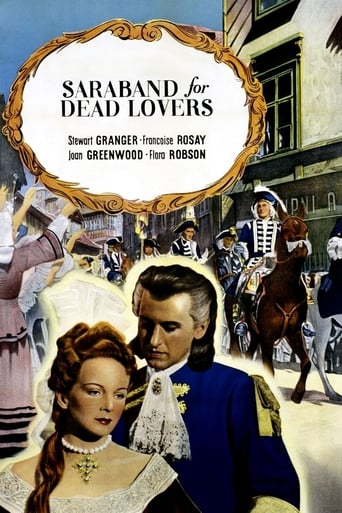

After 40 minutes of this film, I still had no idea what was going on. The story is complicated, confusing, slow-paced, uninteresting and full of talking. This is a true story that has had all the interest taken out of it. No wonder the film is forgotten - it's just not at all engaging. This is a terrible shame, especially as the story deals with the ancestors of the current royal family at the time when their ancestry was about to switch to the German lineage. I feel the film-makers have done a huge dis-service to what should have been a fascinating story. What we get is a slow snorefest of no interest with cast members delivering their dialogue in a very deliberately slow-paced manner. The worst offender is Joan Greenwood as Sophie Dorothea. She is terrible. All her dialogue is overdone in a slow, deliberate manner that is totally inappropriate and spoken for dramatic effect without any realism. The film is basically about a doomed love affair. That's how I'd describe it. However, it should be about so much more given the subject matter and significance to the English monarchy. I must tip my hat to fellow reviewer "theowinthrop" who explains the situation perfectly in his review. I suggest you read that for all the interest and knowledge surrounding this topic and forget about this film. You have been warned!
... View More.....demanded my slightly deaf Uncle Charlie when my aunt read out the local cinema guide. Not charabancs,saraband - it's a dance",she replied with all the authority of a woman who ran Ballet and Tap classes from her parlour for 30 years. I favoured "Lassie" myself but I didn't get a vote and off we trooped to one of the town's four cinemas. Two hours later on the bus home Uncle Charlie maintained he still didn't know what it had been all about. "Lovely costumes",said my aunt. I sat there drawing faces here I had breathed on the window. There was a film about parachutists next week,maybe we could go and see that. "Saraband for dead lovers" was a huge flop with picture goers in its time. Despite good production values and sterling performances its subject matter - an obscure European aristocrat mostly unknown to an audience who were generally strongly opposed to anything even vaguely Germanic three years after the end of World War 2. In recent years more politically sophisticated audiences have caused a reassessment to have been made and it is now accepted as a well -made beautifully produced piece of work,an early example of exquisite use of colour in a British picture. Seventy years later I can hardly blame my eight year old self for finding it less than absorbing. Mr P.Bull makes some interesting references to it in his mem which is well worth looking out.
... View MoreThis is the type of film that shows how one can find interesting small moments in an otherwise rather average film. Buried in the middle of this film is a five minute beautiful example of a montage by rhythm as Joan Greenwood tries to make her way through a chaotic masque ball in order to meet her lover. The sequence climaxes with a series of flash pans and POV shots as we are thrust into the center of the action with the character. The filmmaker inserts fast POV shots of close ups of the masked revelers. The cuts and flash pans are edited rhythmically with the music and make for a wonderful example of a well-executed montage sequence. Show just this sequence to film students.
... View MoreAn enchanting tale of political marriages and schemes for prestige all at the expense of innocent people. It's a disturbing tale especially when you realize how many women in history must have felt as repressed and lonely as our heroine Sophie Dorothea. But it is a beautiful story of a little stolen happiness. Stewart Granger of course is always dashing in a costume drama. I recommend it for all the lovers of romantic tragedy.
... View More